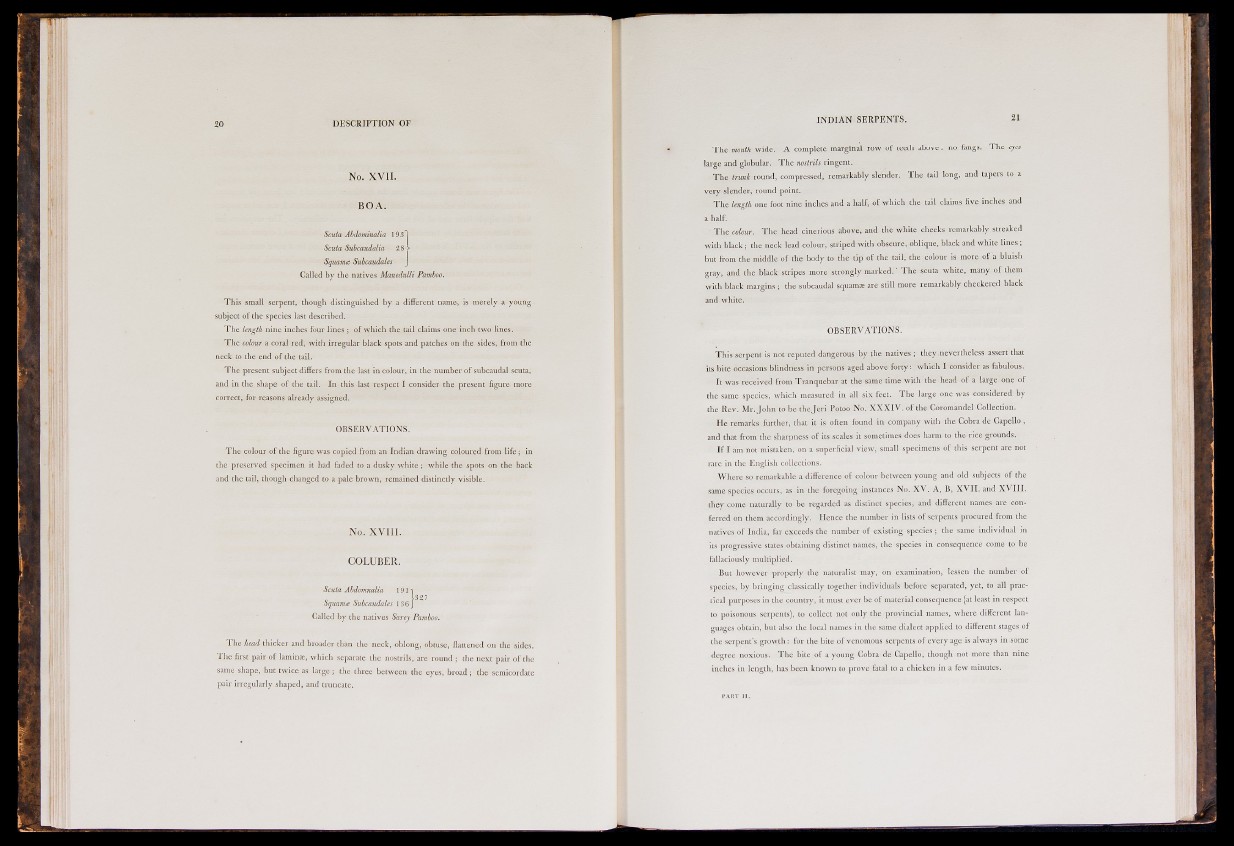
20 DESCRIPTION OF
No. XVII.
BOA.
Scuta Abdominalia 1931
Scuta Suhcaudalia 28 >
Squamie Siibcaudales J
Called by the natives Manedulli Pamboo.
This small serpent, though distinguished by a different name, is merely a young
subject of the species last described.
The length nine inches four lines ; of which the tail claims one inch two lines.
The colour a coral red, with irregular black spots and patches on the sides, from the
neck to the end of the tail.
The present subject differs from the last in colour, in the number of subcaudal scuta,
and in the shape of the tail. In this last respect I consider the present figure more
correct, for reasons already assigned.
OBSERVATIONS.
The colour of the figure was copied from an Indian drawing coloured from life; in
the preserved specimen it had faded to a dusky white ; while the spots on the back
and the tail, though changed to a pale brown, remained distinctly visible.
No. XVIII.
COLUBER.
Scuta Abdomnalia 191 "i
[327
Sqiiamce Siibcaudales 13 6]
Called by the natives Sarey Pamboo.
The head thicker and broader than the neck, oblong, obtuse, flattened on the sides.
The first pair of laminse, which separate the nostrils, are round ; the next pair of the
same shape, but twice as large ; the three between the eyes, broad ; the semicordate
pair irregularly shaped, and truncate.
I N D I A N SERPENTS. 21
The mouth wide. A complete marginal row of teeth above : no fangs. The eyes
large and globular. The nostrils ringent.
The trunk round, compressed, remarkably slender. The tail long, and tapers to a
very slender, round point.
The length one fbot nine inches and a half, of which the tail claims five inches and
a half
The colour. The head cinerious above, and the white cheeks remarkably streaked
with black ; the neck lead colour, striped with obscure, oblique, black and white lines ;
but from the middle of the body to the tip of the tail, the colour is more of a bluish
gray, and the black stripes more strongly marked.' The scuta white, many of them
with black margins ; the subcaudal squama: are still more remarkably checkered black
and white.
OBSERVATIONS.
This serpent is not reputed dangerous by the natives ; they nevertheless assert that
its bite occasions blindness in persons aged above forty: which I consider as fabulous.
It was received from Tranquebar at the same time with the head of a large one of
the same species, which measured in all six feet. The large one was considered by
the Rev. Mr. J o h n to be thejer i Potoo No. XXXIV. of the Coromandel Collection.
He reiuarks further, that it is often found in company with the Cobra de Capello ,
and that from the sharpness of its scales it sometimes does harm to the rice grounds.
If I am not mistaken, on a superficial view, small specimens of this serpent are not
rare in the English collections.
Where so remarkable a difference of colour between young and old subjects of the
same species occurs, as in the foregoing instances No. XV. A, B, XVII, and XVIII.
they come naturally to be regarded as distinct species, and different names are conferred
on them accordingly. Hence the number in lists of serpents procured from the
natives of ' India, far exceeds the number of existing species ; the same individual in
its progressive states obtaining distinct names, the species in consequence come to be
fallaciously multiplied.
But however properly the naturalist may, on examination, lessen the number of
species, by bringing classically together individuals before separated, yet, to afl practical
purposes in the couutry, it must ever be of material consequence (at least in respect
to poisonous serpents), to collect not only the provincial names, where different languages
obtain, but also the local names in the same dialect applied to different stages of
the serpent's growth: for the bite of venomous serpents of every age is always in some
degree noxious. The bite of a young Cobra de Capello, though not more than nine
inches in length, has been known to prove fatal to a chicken in a few minutes.